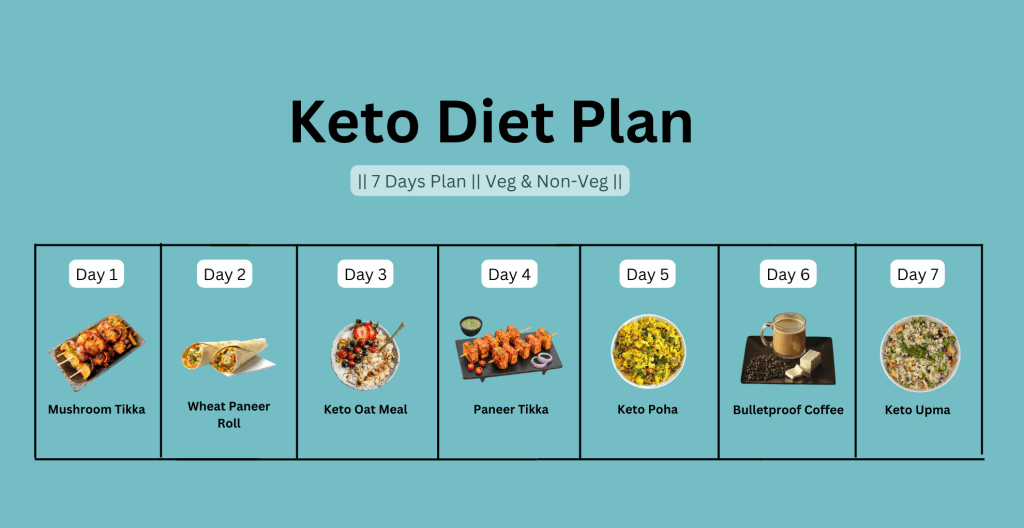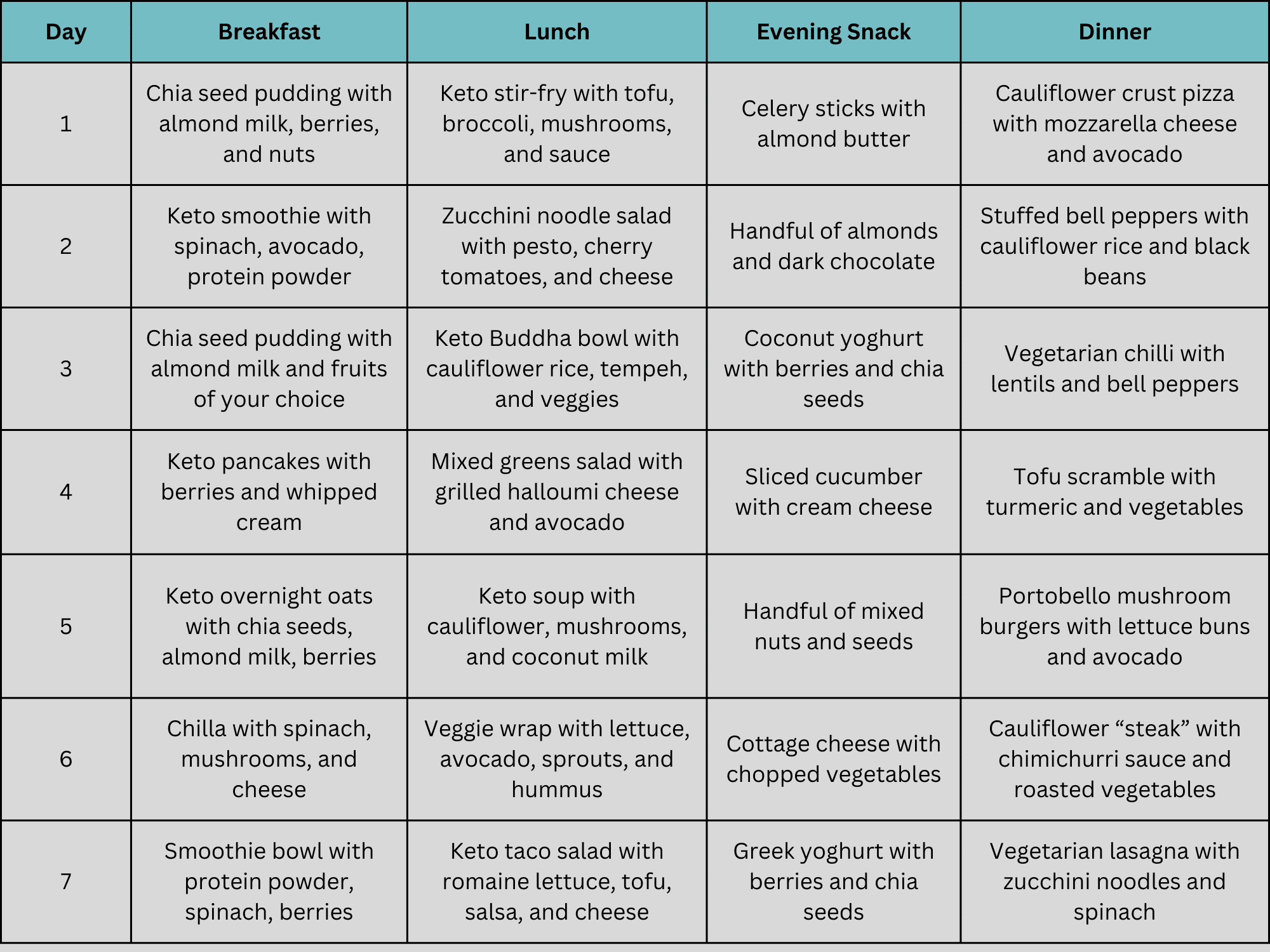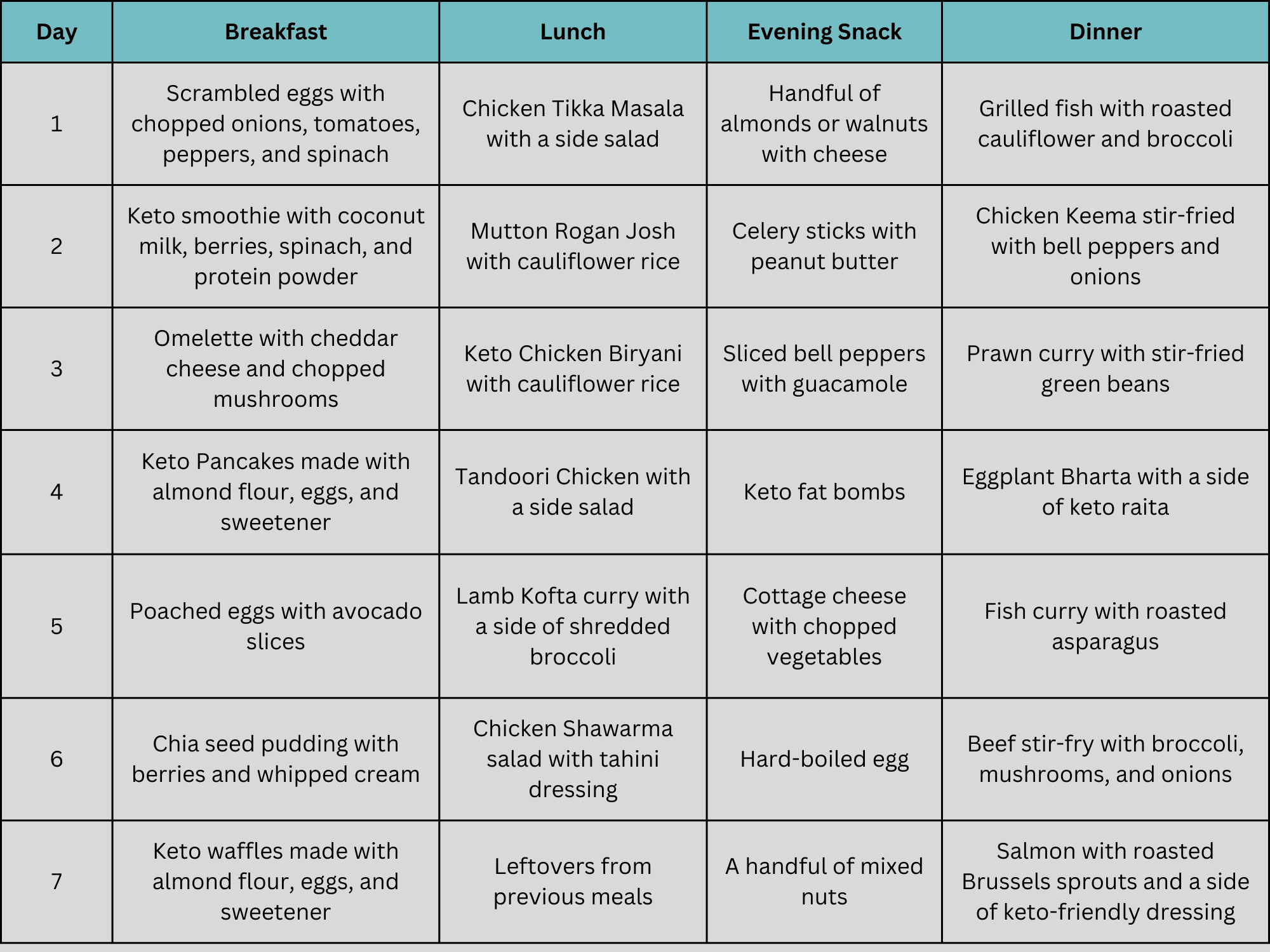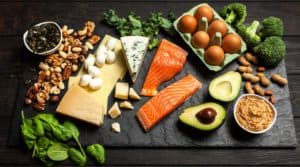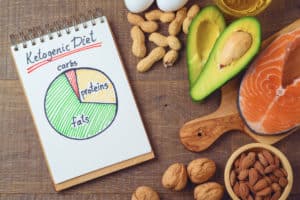The keto diet plan is a popular low-carb, high-fat eating approach that has gained traction as an effective weight loss strategy. This plan focuses on reducing carbohydrate intake to induce a metabolic state called ketosis, where the body utilises stored fat for fuel instead of glucose. By depriving the body of its primary energy source from carbohydrate-rich foods, ketones are produced from fat stores, facilitating weight loss. Beyond weight management, the keto diet plan offers various benefits, including enhanced heart health, reduced acne, and potentially lowered cancer risk.
Different keto plans cater to diverse goals, whether it’s shedding pounds, improving overall health, or accommodating specific dietary preferences. In this article, we delve into the specifics of a keto diet plan tailored specifically for weight loss, detailing foods to avoid and suitable alternatives and providing a sample 7 day Indian keto diet plan. Additionally, we explore how to prepare and optimise the best keto diet plan for effective weight loss.
Can Keto Diet Plan help with weight loss?
Yes, the Keto Diet Plan can be effective for weight loss in some individuals. By drastically reducing carbohydrate intake and increasing the consumption of healthy fats and moderate amounts of protein, the body enters a state called ketosis. In ketosis, the body burns fat for fuel instead of carbohydrates, which can lead to significant weight loss for some people.
According to the School of Medicine, a meta-analysis conducted in 2013, comprising 13 randomised controlled trials, it was discovered that individuals adhering to a well-tailored (the best keto diet plan that could be designed) shed an additional 2 pounds (lbs) compared to those on low-fat diets within a year. Likewise, another review comprising 11 studies indicated that participants on a keto diet experienced a weight loss of 5 lbs more than their counterparts on low-fat diets after 6 months. Hence, it is safe to say that following a plan, or an Indian keto diet plan, can help you sustainably lose weight.
Basics of Keto Diet Plan
The keto diet is a low-carbohydrate, high-fat diet that reduces carbohydrate intake and replaces it with fat. This reduction in carbs puts your body into a metabolic state called ketosis. In ketosis, your body uses fat instead of glucose, which is the primary fuel source of carbohydrates. To understand the basics of the diet, Let’s break down how your macronutrients should be distributed:
- Carbs: Aim for 5-10% of your daily calories from carbs.
- Protein: Moderate protein intake is recommended, at 20-25% of your daily calories.
- Fat: The remaining 70-75% of your calories should come from fat.
By following these macronutrient guidelines, individuals can effectively transition their bodies into ketosis, where fat becomes the primary fuel source. In this state, the body shifts from using glucose (derived from carbohydrates) as its primary energy source to burning fats.
Important things to know before starting the keto diet plan
While a keto diet plan can be effective for weight loss and specific health conditions in the short term, it may not be suitable or necessary for everyone in the long term. Here are some essential things to consider before you start with this diet-
1. Effects of the Ketogenic Diet on Health Conditions
The ketogenic diet may benefit certain health conditions while not being as effective for others. Research into its effects on various diseases, notably diabetes and obesity, is expanding. Initially developed to manage epilepsy, recent studies suggest its potential for promoting weight loss and improving insulin and blood glucose levels, particularly in the initial phases. However, these benefits tend to diminish after approximately a year and can vary depending on comparing the ketogenic diet and other dietary approaches.
2. Food Restrictions while following a keto diet
The ketogenic diet imposes strict limitations on all forms of carbohydrates, resulting in the significant reduction or potential avoidance of entire food groups like dairy, fruits, grains, and vegetables. While the primary objective of carb reduction is to induce and sustain ketosis, it’s important to recognise that carbohydrate-rich foods from these groups are essential components of various dietary patterns known to promote health. Despite this, a well-designed ketogenic diet may incorporate small portions of select fruits like berries and non-starchy vegetables such as broccoli.
Transition Period, “Keto Flu”
You might feel slightly off when you start a keto diet. Your body may need time to adapt to burning fat instead of glucose for energy. This transition period, often called the “keto flu”, can involve symptoms like fatigue, headaches, and irritability. Staying hydrated and ensuring adequate electrolyte intake can help alleviate these symptoms.
It’s not a quick fix: Keto is a lifestyle change, not a fad diet
Aim for long-term success by developing healthy habits. Switching to the keto diet isn’t just about losing weight quickly. It’s more like adopting a whole new lifestyle. Instead of focusing on short-term results, the goal is to make healthy habits that last. That means eating better, being more active, and taking care of yourself in the long run. By seeing keto as a lifestyle change, you set yourself up for success that lasts.
Foods to Eat on Keto Diet Plan
Now that we know what is keto diet and whether it can help reduce weight, let’s look at the foods you must eat while following a keto meal plan. When following a keto diet plan, it’s essential to focus on consuming foods that are low in carbohydrates but high in healthy fats and moderate in protein. Incorporating plenty of non-starchy vegetables, such as leafy greens, broccoli, and cauliflower, can provide essential nutrients and makes the best keto diet plan! By choosing nutrient-dense, keto-friendly foods, you can optimise your chances of success while on an Indian keto diet plan:
1. Protein
Protein is essential for muscle repair, growth, health, and fitness. Including protein-rich foods in your keto diet plan can help you feel fuller for longer and reduce cravings. To support muscle maintenance and development, opt for fatty cuts of meat like ribeye steak, ground beef, pork shoulder, lamb chops, and various poultry options. Here are specific examples of protein-rich foods to add to your keto diet plan;
- Meat: Ribeye steak, ground beef, chicken, turkey, duck.
- Seafood: Salmon, mackerel, sardines, tuna, herring, shrimp, lobster, mussels.
- Eggs: Scrambled, fried, boiled, or as omelettes.
2. Non-Starchy Vegetables
Non-starchy vegetables are rich in fibre, vitamins, and minerals but low in carbohydrates. Incorporating these vegetables into your keto meal plan adds volume and nutrients without significantly increasing calorie intake. To boost nutrient intake and support digestive health, including leafy greens like spinach, kale, arugula, swiss chard, and lettuce. Here are a few examples of non-starchy vegetables that you can easily find and add to your Indian keto diet plan:
- Leafy greens: Spinach, kale, arugula, swiss chard, lettuce.
- Cruciferous vegetables: Broccoli, cauliflower, Brussels sprouts, cabbage.
- Other low-carb veggies: Asparagus, zucchini, yellow squash, bell peppers, mushrooms, and green beans.
3. Healthy Fats
Healthy fats are vital in hormone production, brain function, and overall health. Including sources of healthy fats in your keto diet plan can help increase feelings of satiety and promote fat loss. To support optimal health and energy levels, incorporate avocado, olive oil, coconut oil, nuts, seeds, and fatty dairy products into your meals. Here are other noteworthy options that can be added to an Indian keto diet plan:
- Avocado: Whole avocado or sliced avocado.
- Olive oil: Extra virgin olive oil.
- Coconut oil: Unrefined coconut oil.
- Nuts and seeds: Almonds, walnuts, macadamia nuts, chia seeds, flaxseeds, pumpkin seeds.
- Fatty dairy: Cheese, butter, heavy cream, full-fat yoghurt.
Vegetarian Keto Diet Plan for 7 Days
This 7 day vegetarian keto diet plan is a low-carbohydrate, high-fat diet that eliminates all meat and poultry while allowing dairy and eggs. It is a variation of the traditional keto meal plan, which is typically high in meat and seafood. Each day offers a delicious and nutritious selection of plant-based keto-friendly meals. By focusing on plant-based sources of protein, healthy fats, and low-carb vegetables, this plan provides all the essential nutrients your body needs while promoting fat-burning and weight loss. You can follow this Indian keto meal plan for 7 days, and if required, then you can make changes according to your likes and dislikes!
Day 1
- Breakfast: Chia seed pudding with almond milk, berries, and a sprinkle of nuts (low-carb granola optional)
- Lunch: Keto stir-fry with tofu, broccoli, mushrooms, and a low-carb sauce (sesame oil, ginger, garlic)
- Dinner: Cauliflower crust pizza with mozzarella cheese, roasted vegetables, and avocado
- Snack: Celery sticks with almond butter
Day 2
- Breakfast: Keto smoothie with spinach, avocado, protein powder, and unsweetened almond milk
- Lunch: Zucchini noodle salad with pesto, cherry tomatoes, and mozzarella cheese
- Dinner: Stuffed bell peppers with cauliflower rice, black beans (optional for non-strict keto), cheese, and spices
- Snack: Handful of almonds and dark chocolate (70% cacao or higher)
Day 3
- Breakfast: Chia seed pudding with almond milk and fruits of your choice
- Lunch: Keto Buddha bowl with cauliflower rice, tempeh, roasted vegetables, and a tahini dressing
- Dinner: Vegetarian chilli with lentils (optional for non-strict keto), bell peppers, onions, and spices
- Snack: Coconut yoghurt with berries and chia seeds
Day 4
- Breakfast: Keto pancakes made with almond flour, and low-carb sweetener, topped with berries and whipped cream (made with heavy cream)
- Lunch: Keto salad with mixed greens, grilled halloumi cheese, avocado, and a low-carb vinaigrette
- Dinner: Tofu scramble with turmeric, vegetables, and nutritional yeast
- Snack: Sliced cucumber with cream cheese
Day 5
- Breakfast: Keto overnight oats with chia seeds, almond milk, and berries
- Lunch: Keto soup with cauliflower, mushrooms, and coconut milk
- Dinner: Portobello mushroom burgers with lettuce buns, avocado, and low-carb cheese
- Snack: Handful of mixed nuts and seeds
Day 6
- Breakfast: Chilla with spinach, mushrooms, and cheese
- Lunch: Veggie wrap with lettuce, avocado, sprouts, and hummus
- Dinner: Cauliflower “steak” with chimichurri sauce and roasted vegetables
- Snack: Cottage cheese with chopped vegetables
Day 7
- Breakfast: Smoothie bowl with protein powder, spinach, berries, and almond milk, topped with nuts and seeds
- Lunch: Keto taco salad with romaine lettuce, seasoned tofu crumbles, avocado, salsa, and cheese
- Dinner: Vegetarian lasagna with zucchini noodles, ricotta cheese, spinach, and marinara sauce
- Snack: Greek yoghurt with berries and a sprinkle of chia seeds
This was a sample menu for 7 days. To make the best keto diet plan, you can consult a healthcare professional to ensure you achieve your weight loss goals. Set realistic targets and avoid aiming for rapid weight loss, such as how to lose 10 kgs in 7 days.
Non-Vegetarian Keto Diet Plan for 7 Days
Following a low-carb diet doesn’t necessarily restrict you to vegetarian options. You can achieve the same by incorporating non-vegetarian choices. The key lies in understanding how to eat, what to eat, when, and when to eat when on a keto diet plan. By incorporating a variety of protein-rich meats, seafood, healthy fats, and low-carb vegetables, this non-vegetarian Indian keto diet plan offers a delicious and satisfying way to achieve ketosis while supporting your weight loss goals. Whether you’re a meat lover or simply seeking an effective and sustainable approach to keto, this non-vegetarian Indian keto diet plan provides everything you need for a week of nutritious and flavorful meals:
Day 1
- Breakfast: Scrambled eggs with chopped onions, tomatoes, peppers, and spinach (cooked in ghee)
- Lunch: Chicken Tikka Masala (keto-friendly recipe using almond flour or coconut flour for the gravy) with a side salad (dressed with olive oil and vinegar)
- Dinner: Grilled fish with roasted cauliflower and broccoli (seasoned with spices)
- Snack: Handful of almonds or walnuts with a small piece of cheese
Day 2
- Breakfast: Keto smoothie made with coconut milk, berries, spinach, and protein powder
- Lunch: Mutton Rogan Josh (keto-friendly recipe using minimal tomatoes and thickened with coconut milk) with cauliflower rice
- Dinner: Chicken Keema (minced chicken) stir-fried with bell peppers and onions (cooked in coconut oil)
- Snack: Celery sticks with peanut butter (almond butter for a nut-free alternative)
Day 3
- Breakfast: Omelette with cheddar cheese and chopped mushrooms
- Lunch: Keto Chicken Biryani (using cauliflower rice instead of regular rice)
- Dinner: Prawn curry (cooked in coconut milk) with a side of stir-fried green beans
- Snack: Sliced bell peppers with guacamole
Day 4
- Breakfast: Keto Pancakes made with almond flour, eggs, and sweetener
- Lunch: Tandoori Chicken with a side salad (dressed with olive oil and lemon juice)
- Dinner: Eggplant Bharta with a side of keto raita (made with yoghurt, cucumber, and spices)
- Snack: Keto fat bombs (made with coconut oil, nut butter, and sweetener)
Day 5
- Breakfast: Poached eggs with avocado slices
- Lunch: Lamb Kofta curry with a side of shredded broccoli
- Dinner: Fish curry (cooked in coconut milk) with roasted asparagus
- Snack: Cottage cheese with chopped vegetables
Day 6
- Breakfast: Chia seed pudding with berries and a dollop of whipped cream (unsweetened)
- Lunch: Chicken Shawarma salad with a tahini dressing (low-carb)
- Dinner: Beef stir-fry with broccoli, mushrooms, and onions (cooked in coconut oil)
- Snack: Hard-boiled egg
Day 7
- Breakfast: Keto waffles made with almond flour, eggs, and sweetener
- Lunch: Leftovers from previous meals
- Dinner: Salmon with roasted Brussels sprouts and a side of keto-friendly dressing
- Snack: A handful of mixed nuts
The keto meal plan mentioned above is viable for long-term weight loss. You can customise the plan to suit your preferences and make it more enjoyable. Additionally, explore other diet plans tailored to your specific needs, such as the 85 to 60 kg weight loss diet plan.
Health Benefits of Keto Diet Plan
By drastically reducing carbohydrate intake and promoting the consumption of healthy fats and moderate protein, the keto diet plan triggers a metabolic state known as ketosis. This shift in metabolism facilitates weight loss and helps you achieve goals like ‘how to lose 20 kgs in 3 months’ and offers a range of health benefits that extend to various aspects of physical and mental well-being. From improved blood sugar control and heart health to enhanced brain function and increased energy levels, the keto diet plan holds promise as a comprehensive approach to promoting overall health and vitality. Let’s explore these health benefits of following an Indian keto diet plan in more detail:
1. Improved Blood Sugar Control
The keto diet plan can positively impact blood sugar control through several mechanisms. Firstly, promoting weight loss can reduce strain on the cardiovascular system, leading to better circulation. Additionally, the diet’s ability to reduce inflammation and enhance insulin sensitivity may further improve heart health, thereby supporting better blood circulation and glucose regulation.
2. Heart Health
Adopting a simple keto diet meal plan may help mitigate risk factors associated with cardiovascular diseases, such as hypertension and high cholesterol levels. The keto diet plan can improve lipid profiles and overall heart health by emphasising healthy fats and limiting refined carbohydrates. However, the long-term effects of this diet on heart health are still being researched, and it’s crucial to follow the diet cautiously and consult healthcare professionals to ensure individual health needs are addressed.
3. Healthy Brain Function
Evidence suggests that adhering to a keto diet meal plan may enhance cognitive function and protect against various neurological disorders such as Alzheimer’s and Parkinson’s disease. Additionally, it has been proposed that the keto diet plan could aid in addressing sleep issues and even certain types of cancer. However, while promising, more concrete experimental data are needed to fully validate the efficacy of the diet in managing these conditions.
4. Increased Energy Functions
Following a keto diet plan, the body transitions from primarily using carbohydrates for energy to burning fat for fuel. This metabolic shift occurs as the liver produces ketones from stored fat, an alternative energy source for the body and brain. As individuals adapt to burning fat for fuel, they often experience more stable and sustained energy levels throughout the day. Unlike the rapid spikes and crashes in energy that can occur with carbohydrate-rich diets, the steady supply of energy from fat metabolism on a keto diet meal plan can help prevent feelings of fatigue and lethargy.
Foods to Avoid on Keto Diet Plan
The key to achieving success with the keto meal plan is straightforward: reduce your carbohydrate consumption and derive most of your calories from fat. Grains pose a challenge as they are rich in carbohydrates, hindering progress on the keto diet plan journey. It is advisable to strike out such foods to make the best keto diet plan.
Foods to avoid while following an Indian keto diet plan include;
1. Grains
Grains are rich in carbohydrates, which can impede ketosis, where the body burns fat for fuel instead of carbs. Avoiding grains like bread, cereal, pasta, and baked goods helps maintain ketosis and supports weight loss when on the keto meal plan. Here are certain grains that you must avoid while following the keto diet plan:
- All types of bread, including: white bread, wheat bread, sourdough bread, whole-wheat bread, bagels, pita bread, tortillas, wraps, buns, English muffins, croissants, and crackers.
- Cereals: oatmeal, granola, muesli, puffed rice, cornflakes, bran flakes, and any cereal made with wheat, barley, oats, or rye.
- Pasta: all types of pasta made with wheat, rice, or other grains, including spaghetti, macaroni, lasagna, penne, and fettuccine.
- Baked goods: cookies, cakes, muffins, pastries, pies, doughnuts, brownies, and other desserts made with flour, sugar, and starches.
2. Starchy Vegetables
Starchy vegetables like potatoes, sweet potatoes, and corn are high in carbs, making them unsuitable for the keto diet. Restricting these vegetables helps control carbohydrate intake and promotes ketosis. Lookout to avoid these starchy veggies from your keto diet plan:
- Root vegetables: potatoes, sweet potatoes, yams, parsnips, beets, carrots, turnips, rutabagas, and jicama.
- Winter squashes: butternut squash, acorn squash, spaghetti squash, pumpkin, and kabocha squash.
- Corn: kernels, cobs, and creamed corn.
- Peas: green peas, snow peas, and sugar snap peas.
3. Fruits
While nutritious fruits contain natural sugars that can elevate blood sugar levels and hinder ketosis, avoiding high-sugar and dried fruits helps regulate carbohydrate intake and supports ketosis when following the Indian keto diet plan.
- All fruits are generally restricted due to their natural sugar content. Still, some are exceptionally high in sugar and should be avoided entirely: bananas, mangoes, grapes, pineapples, oranges, apples, pears, melons (watermelon, honeydew, cantaloupe), dates, figs, and raisins.
- Dried fruits: raisins, cranberries, apricots, prunes, mangoes, and any other dried fruit.
- Fruit juices: all fruit juices are high in sugar and carbohydrates, even if labelled “100% natural” or “no sugar added.”
4. Legumes and Beans
Legumes and beans are carb-rich foods that can interfere with ketosis. Avoiding beans like kidney beans, chickpeas, peanuts, and peanut butter helps maintain ketosis and supports weight loss on the keto diet. Here’s what to strike off from your keto diet plan:
- All types of beans: kidney beans, pinto beans, black beans, chickpeas (garbanzo beans), lentils, and soybeans.
- Peanuts and peanut butter: due to their higher carbohydrate content compared to other nuts and nut butter.
5. Sugary Drinks
Sugary drinks like soda, fruit juices, and sweetened teas are high in carbohydrates and can disrupt ketosis. Avoiding these beverages helps reduce carb intake and promotes ketosis while following the keto diet meal plan:
- Soda, including diet and sugar-free sodas: artificial sweeteners may hinder ketosis in some individuals.
- Sports drinks and energy drinks are often packed with carbohydrates and sugar.
- Fruit juices and sweetened teas: high in sugar and carbohydrates.
- Sweetened coffee drinks and flavored lattes: contain added sugars and syrups.
- Alcoholic beverages: while some argue for limited alcohol consumption on keto, it can disrupt ketosis and hinder weight loss goals. Consult a healthcare professional for guidance.
6. Other Condiments and Sauces
Many condiments and sauces contain added sugars and carbs, hindering ketosis. Opting for sugar-free alternatives and homemade dressings helps control carbohydrate intake and supports ketosis on the keto diet. Strike out the following when on a keto diet meal plan:
- Ketchup, barbecue sauce, teriyaki sauce, marinades with added sugars, and store-bought salad dressings often contain hidden sugars and carbohydrates. Opt for homemade dressings with olive oil, vinegar, spices, and herbs.
- Honey, maple syrup, agave nectar, and other sweeteners are all high in carbohydrates and will spike blood sugar levels.
- Most commercially prepared sauces and dips often contain added sugars, thickeners, and starches. Choose homemade options or sugar-free alternatives.
7. Processed and Packaged Foods
Processed and packaged foods often contain hidden sugars, unhealthy fats, and fillers that are not keto-friendly. Avoiding these foods helps maintain ketosis and supports overall health on the keto diet meal plan:
- Most packaged snacks: chips, crackers, pretzels, cookies, candy bars, and granola bars are typically high in carbohydrates and unhealthy fats.
- Breakfast cereals and bars are often loaded with grains, sugar, and unhealthy fats.
- Pre-made meals and frozen dinners frequently contain hidden sugars, unhealthy fats, and fillers that are not keto-friendly.
- Fast food: generally high in unhealthy fats, carbohydrates, and hidden sugars.
Best Indian Keto Diet Recipes
Preparing meals for your Indian Keto diet plan can sometimes be laborious. Here’s something helpful while looking for Indian keto diet recipes: look for recipes with the ingredients available in your kitchen and those you already use in the household recipes. Further, choose seasonal vegetables that are fresh and easily available so that you can add them to your Indian keto diet plan. Here are a few to help with easy-to-find ingredients that can make the best keto diet plan;
1. Paneer Tikka: This high-protein snack involves marinating chunks of paneer in a mixture of yoghurt and Indian spices like cumin, coriander, and garam masala. Grilling or baking the marinated paneer creates a delicious and satisfying option for the Indian keto diet plan.
2. Masala Nuts: Almonds, walnuts, and cashews are rich in healthy fats and low in carbs. Roasting them with a blend of Indian spices, such as chaat masala or cumin, adds a flavorful twist to these crunchy, keto-compliant snacks.
3. Cucumber Chaat: Cucumbers are low in carbs and are an excellent base for a keto meal plan. Toss them with a chaat masala, lemon juice squeeze, and a pinch of salt for a refreshing and tangy snack.
4. Egg Bhurji: This dish involves scrambling eggs with finely chopped onions, tomatoes, and green chillies seasoned with traditional Indian spices. Eggs are a great protein and healthy fat source, making egg bhurji is a satisfying pick and can help you curate the best keto diet plan!
5. Keto-friendly Samosas: Modify the traditional samosa recipe using almond flour instead of regular flour for the outer layer. Stuff it with a low-carb mixture of cauliflower, spinach, and paneer. Bake rather than deep-frying for a keto-approved treat.
Snacks Options To Eat On Keto Diet Plan
When choosing snacks, it is essential to read labels carefully and select options low in net carbs and high in healthy fats and protein. And yes, preparing your keto meal plan’s snacks at home is always best! Here are five easy-to-make keto-friendly evening snacks that can help you prepare the best keto diet plan:
- Hard Boiled Eggs: A staple snack in the keto diet plan, hard-boiled eggs are rich in protein and healthy fats, making them a satisfying option. Sprinkling them with black pepper adds flavor without adding carbs.
- Yoghurt with grated beetroot: This snack is not only visually appealing but also nutritious, providing protein, antioxidants, and fibre. The combination of yoghurt and grated beetroot offers a satisfying and filling snack. You can add such interesting snacks to prepare the best keto diet plan for yourself!
- Berries: Available year-round in supermarkets, berries are low in carbs and high in fiber and antioxidants, making them an ideal choice for keto-friendly snacking. Whether it’s strawberries, blueberries, or raspberries, berries can satisfy your sweet cravings without derailing your keto goals and add up to the best keto diet plan for you!
- Nuts and Seeds: Loaded with protein, healthy fats, and fiber, nuts and seeds are versatile keto snacks. Almonds, walnuts, pecans, pumpkin seeds, and sunflower seeds are excellent options for satisfying hunger between meals while providing essential nutrients.
- Keto Smoothies: A delicious and convenient way to incorporate vitamins, minerals, and protein into your diet, keto smoothies can be customized to fit your taste preferences and nutritional needs. Using keto-friendly protein powder and low-carb fruits and vegetables ensures that your smoothie remains within your daily carb limit while providing essential nutrients for optimal health.
Expert Review on Keto Diet Plan
The keto diet plan is one of many approaches to weight loss and overall health improvement. The keto diet plan triggers a metabolic state called ketosis by drastically reducing carbohydrate intake and increasing the consumption of healthy fats and moderate protein. This metabolic shift helps individuals shed excess weight and offers various health benefits. These benefits include improved blood sugar control, enhanced heart health, better brain function, increased energy levels, and more stable moods throughout the day. While the keto diet requires careful planning and monitoring, its potential to promote weight loss and improve overall health makes it a compelling option for those seeking a sustainable lifestyle change. It is noteworthy that you must explore and buy a keto diet plan, which shall be effective for weight loss in both the short and long term. It may also help improve blood sugar control in people with type 2 diabetes.
References
- Al-Sowayan, Noorah. n.d. “(PDF) The Effect of Ketogenic-Diet on Health.” ResearchGate. Accessed November 30, 2023. https://www.researchgate.net/publication/340836452_The_Effect_of_Ketogenic-Diet_on_Health.
- Batch, Jennifer T. 2020. “Advantages and Disadvantages of the Ketogenic Diet: A Review Article.” NCBI. https://www.ncbi.nlm.nih.gov/pmc/articles/PMC7480775/.
- “Effects of ketogenic diet on health outcomes: an umbrella review of meta-analyses of randomized clinical trials – BMC Medicine.” 2023. BMC Medicine. https://bmcmedicine.biomedcentral.com/articles/10.1186/s12916-023-02874-y
- Kubala, Jillian. n.d. “Keto diet: Benefits and nutrients.” Medical News Today. Accessed November 30, 2023.
https://www.medicalnewstoday.com/articles/319196#7-improves-pcos-symptoms
FAQs
How do I start a keto diet plan?
To begin a keto diet plan, educate yourself about its principles, emphasising high fat, moderate protein, and minimal carbs. Adjust your meals to include whole, unprocessed foods while gradually reducing carb intake. Be mindful of potential side effects during the adjustment period, such as the “keto flu,” and stay hydrated while replenishing electrolytes. Additionally, consider meal planning and tracking macros to ensure you’re meeting your nutritional needs. Consulting with a healthcare professional or a registered dietitian can offer personalised guidance on your keto journey.
What foods do you eat on a keto diet?
On a keto meal plan, the primary focus is on consuming foods high in healthy fats, moderate in protein, and very low in carbohydrates. These include foods such as fatty cuts of meat like beef, pork, and chicken; fatty fish like salmon and mackerel; eggs; nuts and seeds; healthy oils like olive oil and coconut oil; avocados; and low-carb vegetables like leafy greens, broccoli, cauliflower, and zucchini. Additionally, dairy products such as cheese and Greek yoghurt (unsweetened) can be included in your Indian keto diet plan in moderation.
What are the basic rules of a keto diet?
The basic rules of a keto diet plan revolve around drastically reducing carbohydrate intake to induce a metabolic state called ketosis, where the body switches from burning glucose for fuel to burning fat. This involves consuming fewer than 50 grams of net carbohydrates daily, focusing on high-fat foods like fatty meats, fish, avocados, and oils, and avoiding high-carb foods like grains, sugar, starchy vegetables, and most fruits.
What is a keto diet plan?
A keto diet plan is a structured eating regimen that promotes ketosis and facilitates weight loss. It involves meal plans and recipes that adhere to keto-friendly foods while excluding high-carb items. An Indian keto diet plan consists of meals high in healthy fats, moderate in protein, and very low in carbohydrates. The goal is to achieve and maintain a state of ketosis by following the plan’s guidelines.
Can you drink milk on keto?
While milk is relatively high in carbohydrates due to its lactose content, small amounts of whole milk can be consumed if it fits within your daily carb allowance. However, many people on the Indian keto diet plan prefer alternatives like almond milk, coconut milk, or unsweetened soy milk, which are lower in carbs and can be included more freely.
Can you eat rice on keto?
Rice is high in carbohydrates and is generally not considered compatible with a strict keto diet. However, low-carb alternatives like cauliflower or shirataki rice can be substituted for traditional rice in keto-friendly recipes.
Is banana good for keto?
Bananas are relatively high in carbohydrates and sugar, making them less suitable for a strict keto diet plan. However, small portions of bananas may be incorporated into a keto diet plan if they fit within your daily carb allowance. It’s essential to monitor portion sizes and consider the impact on ketosis.
What fruit is keto-friendly?
Keto-friendly fruits are low in carbohydrates and sugar. Examples include berries like strawberries, raspberries, blackberries, and blueberries, as they have a lower glycemic index and are higher in fibre than other fruits. Avocados are also considered keto-friendly due to their high healthy fat content and low net carbs.
Can I eat tomato on keto?
Tomatoes are relatively low in carbohydrates and can be included in moderation on an Indian keto diet plan. However, monitoring portion sizes and considering the carb content is essential, especially if you consume other higher-carb foods throughout the day.

